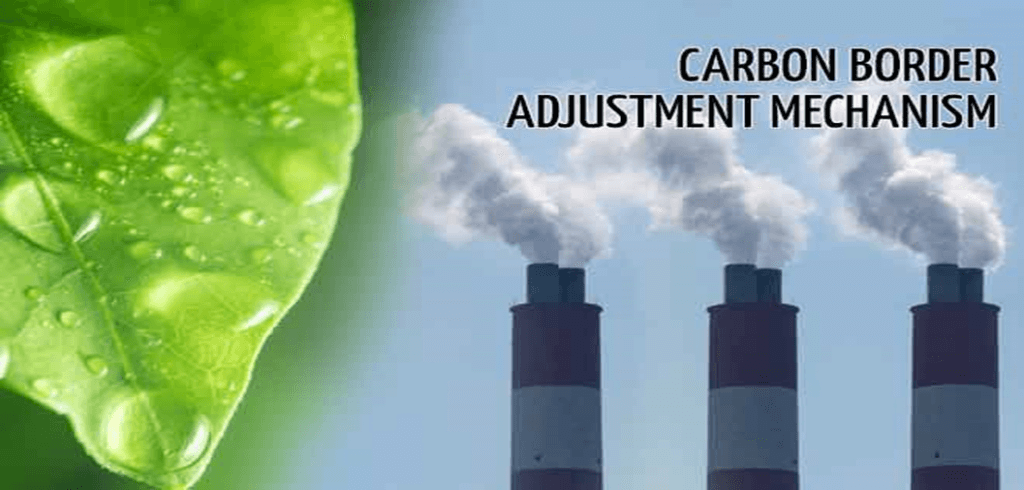The Carbon Border Adjustment Mechanism (CBAM) has been hailed as a groundbreaking tool that aims to place a fair price on the carbon emissions associated with the production of carbon-intensive goods entering the European Union (EU). Its implementation is expected to incentivize cleaner industrial production practices in non-EU countries. In this essay, we will explore the details of the CBAM and examine the concerns it raises for India and other countries.

Details of the CBAM:
- Purpose and Implementation Timeline:
- The CBAM aims to establish a fair price on carbon emitted during the production of carbon-intensive goods entering the EU.
- The reporting system under the regulation is set to be enforced from October 2023.
- Importers will begin paying the financial levy from 2026.
- Once fully implemented, importers in the EU will be required to purchase carbon certificates corresponding to the payable carbon price of the import, as if the product had been produced within the continent.
- Reciprocity:
- If a non-EU producer pays a price or tax for the carbon used to produce the imported goods in their home country or elsewhere, the corresponding cost will be deducted for the EU importer.
- This provision promotes fairness and prevents double carbon taxation.
- Responsibility and Verification:
- The European Commission, in collaboration with relevant authorities of member states, will review and verify declarations from importers.
- They will also manage the central platform for the sale of CBAM certificates.
Concerns for India and Other Countries:
- Initial Application and Coverage:
- The CBAM will initially apply to imports of certain goods with carbon-intensive production processes, including cement, iron and steel, aluminum, fertilizers, electricity, and hydrogen sectors.
- Once fully phased in, it is expected to capture more than half of the emissions in sectors covered by the EU Emissions Trading System (ETS).
- Exposure and Impact:
- According to the United Nations Conference on Trade and Development (UNCTAD), Russia, China, and Turkey are the most exposed to the CBAM.
- Developing countries such as India, Brazil, and South Africa are expected to be the most affected.
- India’s exports to the EU account for about 14% of its total export mix, including steel and aluminum.
- Since Indian products have higher carbon intensity compared to their European counterparts, the carbon tariffs imposed will be proportionally higher, making Indian exports significantly less competitive.
- International Climate Policies and Implications:
- The implementation of the CBAM and other international climate policies may prompt other countries to impose similar regulations.
- This could have a significant impact on India’s trading relationships and balance of payments.
- India will likely face challenges in adapting its industries to comply with new regulations, potentially affecting its competitiveness in global markets.
Important Points:
- The Carbon Border Adjustment Mechanism (CBAM) aims to put a fair price on carbon emissions from imported goods entering the EU. 🌍💰
- The CBAM will encourage cleaner industrial production in non-EU countries. ♻️🏭
- Importers in the EU will have to purchase carbon certificates corresponding to the carbon price of the import if it had been produced within the EU. 💼📜
- Reciprocity measures will be in place, allowing for the deduction of carbon costs if the non-EU producer has paid for carbon elsewhere. ↔️✅
- The European Commission, along with member states’ authorities, will verify declarations and manage the central platform for CBAM certificates. 🇪🇺🔍
- The CBAM will initially apply to carbon-intensive sectors such as cement, iron and steel, aluminum, fertilizers, electricity, and hydrogen. 🏗️⚙️💡
- Russia, China, and Turkey are most exposed to the CBAM, while India, Brazil, and South Africa will be most affected among developing countries. 🇷🇺🇨🇳🇹🇷🇮🇳🇧🇷🇿🇦
- Indian exports to the EU, including steel and aluminum, account for about 14% of its total export mix. 🇮🇳📦🇪🇺
- Indian exports will face higher carbon tariffs due to their higher carbon intensity, making them less competitive in the EU market. 📉🔢
- The CBAM and other climate policies may lead to similar regulations worldwide, impacting India’s trading relationships and balance of payments. 🌐💼💸
Why In News
The Carbon Border Adjustment Mechanism (CBAM) is widely praised as an innovative solution designed to establish an equitable cost for the carbon emissions connected to the manufacturing of carbon-intensive goods imported into the European Union (EU). Its introduction is anticipated to foster the adoption of greener industrial production methods in nations outside the EU.
MCQs about Carbon Border Adjustment Mechanism
-
Which of the following best describes the main objective of the Carbon Border Adjustment Mechanism (CBAM)?
A. To promote international trade agreements
B. To impose higher taxes on carbon-intensive goods
C. To encourage cleaner industrial production practices
D. To restrict imports from non-EU countries
-
Which sectors will be initially targeted by the CBAM?
A. Agriculture and textiles
B. Energy and telecommunications
C. Cement, iron and steel, aluminum, fertilizers, electricity, and hydrogen
D. Pharmaceuticals and healthcare
-
Among the developing nations, which countries are expected to be most affected by the CBAM?
A. India, Brazil, and South Africa
B. Russia, China, and Turkey
C. United States, Canada, and Mexico
D. Australia, New Zealand, and Indonesia
-
What potential impact can the CBAM have on Indian exports to the EU market?
A. Increased competitiveness due to lower carbon tariffs
B. No impact on competitiveness as India has low carbon intensity
C. Decreased competitiveness due to higher carbon tariffs
D. No impact on competitiveness as the CBAM only applies to specific sectors
Boost up your confidence by appearing our Weekly Current Affairs Multiple Choice Questions
![]()


